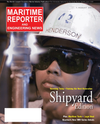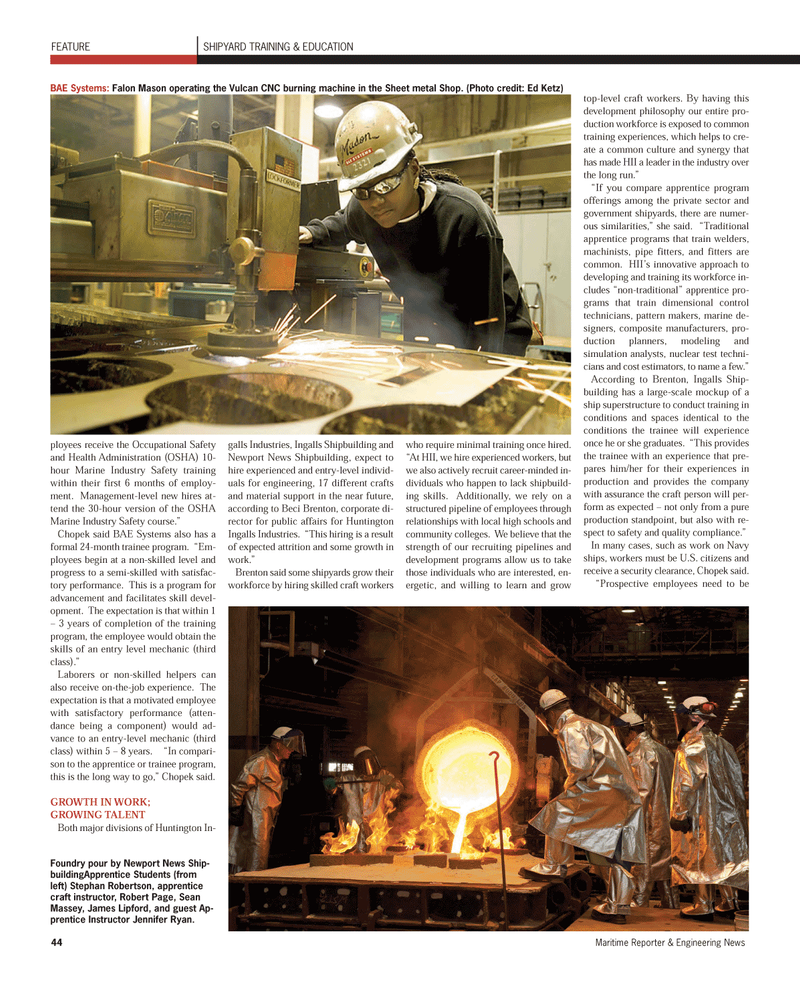
Page 44: of Maritime Reporter Magazine (August 2011)
Top 20 Shipyards of the World
Read this page in Pdf, Flash or Html5 edition of August 2011 Maritime Reporter Magazine
ployees receive the Occupational Safety and Health Administration (OSHA) 10- hour Marine Industry Safety trainingwithin their first 6 months of employ- ment. Management-level new hires at- tend the 30-hour version of the OSHA Marine Industry Safety course.? Chopek said BAE Systems also has a formal 24-month trainee program. ?Em-ployees begin at a non-skilled level and progress to a semi-skilled with satisfac- tory performance. This is a program for advancement and facilitates skill devel- opment. The expectation is that within 1 ? 3 years of completion of the trainingprogram, the employee would obtain the skills of an entry level mechanic (third class).? Laborers or non-skilled helpers canalso receive on-the-job experience. The expectation is that a motivated employee with satisfactory performance (atten- dance being a component) would ad- vance to an entry-level mechanic (third class) within 5 ? 8 years. ?In compari- son to the apprentice or trainee program,this is the long way to go,? Chopek said. GROWTH IN WORK; GROWING TALENT Both major divisions of Huntington In- galls Industries, Ingalls Shipbuilding and Newport News Shipbuilding, expect to hire experienced and entry-level individ- uals for engineering, 17 different crafts and material support in the near future,according to Beci Brenton, corporate di-rector for public affairs for Huntington Ingalls Industries. ?This hiring is a result of expected attrition and some growth in work.? Brenton said some shipyards grow their workforce by hiring skilled craft workers who require minimal training once hired.?At HII, we hire experienced workers, but we also actively recruit career-minded in- dividuals who happen to lack shipbuild- ing skills. Additionally, we rely on a structured pipeline of employees through relationships with local high schools andcommunity colleges. We believe that the strength of our recruiting pipelines anddevelopment programs allow us to take those individuals who are interested, en- ergetic, and willing to learn and grow top-level craft workers. By having this development philosophy our entire pro- duction workforce is exposed to common training experiences, which helps to cre- ate a common culture and synergy that has made HII a leader in the industry over the long run.? ?If you compare apprentice programofferings among the private sector and government shipyards, there are numer- ous similarities,? she said. ?Traditional apprentice programs that train welders,machinists, pipe fitters, and fitters are common. HII?s innovative approach to developing and training its workforce in- cludes ?non-traditional? apprentice pro-grams that train dimensional controltechnicians, pattern makers, marine de- signers, composite manufacturers, pro- duction planners, modeling andsimulation analysts, nuclear test techni-cians and cost estimators, to name a few.? According to Brenton, Ingalls Ship- building has a large-scale mockup of a ship superstructure to conduct training inconditions and spaces identical to theconditions the trainee will experience once he or she graduates. ?This provides the trainee with an experience that pre- pares him/her for their experiences in production and provides the company with assurance the craft person will per- form as expected ? not only from a pure production standpoint, but also with re- spect to safety and quality compliance.? In many cases, such as work on Navy ships, workers must be U.S. citizens and receive a security clearance, Chopek said. ?Prospective employees need to be 44Maritime Reporter & Engineering News FEATURE SHIPYARD TRAINING & EDUCATION Foundry pour by Newport News Ship- buildingApprentice Students (from left) Stephan Robertson, apprentice craft instructor, Robert Page, Sean Massey, James Lipford, and guest Ap- prentice Instructor Jennifer Ryan. BAE Systems: Falon Mason operating the Vulcan CNC burning machine in the Sheet metal Shop. (Photo credit: Ed Ketz) MR Aug. 11 # 6 (42-49):MR Template 8/3/2011 10:57 AM Page 44

 43
43

 45
45
